Odds & Ends: Adventures in the Forgotten Realms, Part 1
Every set, I like to do a mailbag column or two where I answer some of your questions about the latest set. Here's the tweet I put out:
It's time for me to write a mailbag column about #MTGAFR. Please keep your questions about D&D: Adventures in the Forgotten Realms to a single tweet, one question per tweet. Thanks. #WotCStaff
— Mark Rosewater (@maro254) July 2, 2021
As always, I'll try to answer as many questions as I can, but here's why I might not answer your question:
- I have an allotted word count, which means that there are only so many questions I can get to.
- Someone else might have asked the same question. I will usually answer the first person who asks.
- Some questions I either don't know the answer to or don't feel qualified enough in the area to answer properly.
- Some topics I'm not allowed to answer for all sorts of reasons, including previews for future sets.
That said, on with the questions:

For the most part, we've stopped using the Tribal card type (although we still often do tribal themes—e.g., themes involving creature types). In Modern Horizons 2, we thought the connection to Lhurgoyfs with Altar of the Goyf was cool enough we made a special exception to reuse it. The fact that it's a supplement set aimed at enfranchised players helped us decide that it was okay to do.
I won't say that we'll never do a Tribal card again, but it will be very, very infrequent. On top of that, not all the classes are also creature types (such as Fighter Class), so it would have been awkward to use Tribal on some of the Class cards but not all of them.
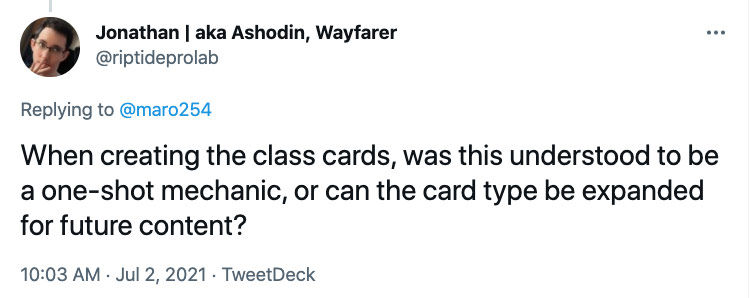
There are two layers to Class enchantments. First is the special flavor of classes. Second is the structure of an enchantment that boosts the player over time. The first is narrow, so there's not a lot of space left. Yes, Magic does have classes that don't show up in D&D, so there's a little space there. The second shows a lot more promise.
If you were to ask me about the greatest chance for the future of this mechanic, it would be to flavor it as some additional way that the player might grow more efficient over time. Maybe we keep the subtype Class, maybe not. It depends on how we flavor it.
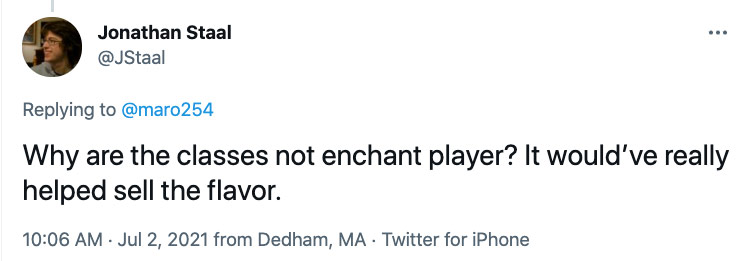
The design team did consider it. Here were the two biggest strikes against it:
- The text boxes were already crowded, and enchant player would add extra text.
- While we usually design enchant players to go on either you or the opponent as a default, they're usually designed so that, on some of them, you'd occasionally do the opposite, and the design team couldn't find any good reasons you'd stick one of these on the opponent.

The Class enchantments evolved from the design team seeing if they could bring back the level-up mechanic (from Rise of the Eldrazi). As they were playing around with tweaking level up, they came to the realization that the creatures weren't supposed to be the ones who leveled up, the players were. So, I'm highly skeptical they made Aura versions, as that contradicted their motivation for making the Class enchantments in the first place.

Between Adventures in the Forgotten Realms and its ancillary products, there are three dungeons (Dungeon of the Mad Mage, Lost Mine of Phandelver, and Tomb of Annihilation).
Why only three? Two main reasons: First is design space. There are only so many small incremental effects, and we wanted each dungeon to feel distinct from the other dungeons. Second is play design. Every dungeon makes venture more powerful. For example, the first time you venture into a dungeon, you have a choice of three different effects. Each time we make an additional dungeon, it gives you an additional option and makes venture stronger.
Will we ever make additional dungeons in the future? I won't say no, because there's definitely a future I can imagine where we do, but I do want to stress that it's a high bar. For starters, it's a set that requires venture being in the set.
Also, the dungeons that exist are very Dungeons & Dragons themed, so I'm pretty sure future uses of venture would probably have to be in a Dungeons & Dragons-themed set.
Finally, making more dungeons ups the power level of the mechanic, which probably means it would be at a time where it's not in Standard and indicates that it would have to return in a supplemental product. So, I'll say it's possible, but not highly probable.
Q: Green and Treasures: On the one side, green cares about mana, but Treasures don't feel green. Question: Are there any other reasons other than it creating mana that set Treasures secondary to green?

Treasure tokens are primary in red because it's the color that cares most about one-shot bursts of mana. They're secondary in green because it's the color most connected to mana and the one that has the easiest time providing access to other colors of mana. Mechanically, green is by far number two in what Treasure tokens do, which is why it's secondary there.
So, let's examine the flavor issue since I think that's more where this disconnect is coming from. I know we most often portray treasure as something like gold coins, but it's a broad term that can apply to many different flavors. For example, nature is full of items that are considered valuable because of their scarcity. Yes, green might not be all that interested in printing money, but it does understand and respect that there are natural things that other people value. Green wouldn't have issue with gems or raw metals or really any natural item from which others might benefit. Creating Treasure tokens with green might not be flavored like other colors' use of Treasure tokens, but green can use them both mechanically and flavorfully.
All that said, we often use Treasure tokens when they reinforce a particular flavor in a set, like Pirates, so which colors use them will vary greatly based on the needs of the set.
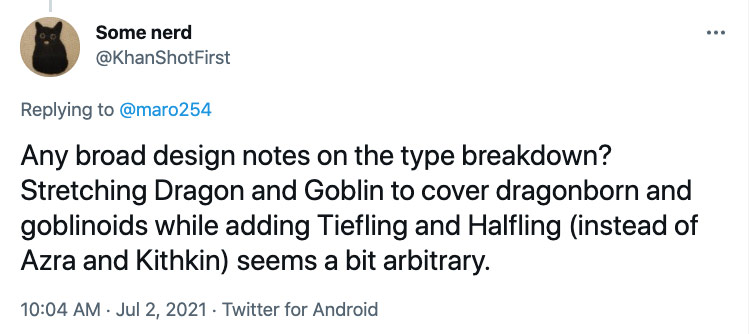
This was one of the most common questions about Dungeons & Dragons: Adventures in the Forgotten Realms. Why did we sometimes use existing Magic creature types and other times use brand-new ones? There are a lot of subtle issues case by case, but let me hit upon the major direction we took.
First, if D&D and Magic used the same terminology, we tried to make use of it if we could. For example, Magic and D&D both have Elves and Dwarves and Orcs, so all those creatures used those labels.
Second, if D&D used a term that in D&D was connected to an existing Magic creature type, we tried to use that as well. For example, hobgoblins and bugbears are connected to Goblins in D&D, so it seemed flavorful to use Goblin for them rather than making new terms. Dragonborn was a similar case. Dragons are an existing creature type. Dragonborn are obviously tied to Dragons in D&D, and using dragonborn as a creature type would just cause confusion with all the Dragon tribal cards (and make all the Dragon fans sad), so we decided to just use the Dragon creature type. They're Dragonoids much like Leonin are Cat people or Loxodon are Elephant folk.
Sometimes there are creature types where Magic has made their own version of it. Magic didn't have Halflings, it had Kithkin. It didn't have Tieflings, it had Azra. In those cases, we chose to go with the D&D versions because it felt odd to refer to them by the Magic version. As an example, Kithkin are similar to Halflings in many ways, but are also quite distinct in others. Calling a Halfling a Kithkin, when clearly creatively they're not, felt jarring.
This also allowed us to get more D&D words onto cards. Obviously, we used Magic words whenever we could, but when we couldn't, we leaned toward D&D terms. I do admit that there were some judgment calls to be made. For example, we talked about whether a Beholder is an Eye and just decided it was different enough, and iconic enough to D&D, to just use its D&D name.

There's a phrase I use a lot on my blog: "success breeds repetition." What this means is that when you do something and you get a positive response, there's a lot of momentum to do it again. The reception to the set, so far, has been very good, so that's a positive sign.
The other big thing in its favor is that Wizards of the Coast makes Dungeons & Dragons. Licensed products are always more complicated because you have two different companies signing off on most major decision. Having both Magic and Dungeons & Dragons under one roof makes that a little easier.
So, while I can't give a definitive yes, I can say I'm optimistic that if Adventures in the Forgotten Realms is a success, the chance of more D&D Magic products is high.
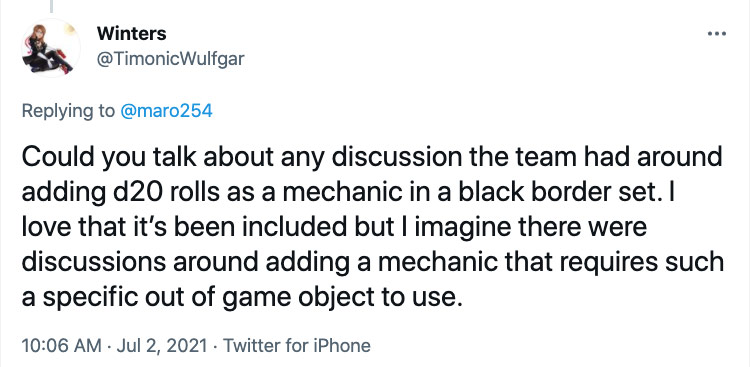
There was a lot of talk about whether adding die rolling to a black-bordered product was a good idea. The biggest concern was that it adds variance in a loud way and, for the players more focused on competitive play, it feels like it lessens skill (there's a bunch of skill in reacting to variance, but that's really a topic for a different column).
The solution to this problem was twofold. One was being careful about the delta of differences between the rolls. No matter what you roll, the cards (mostly) do the thing the card is supposed to do. Yes, things can get better, but you can rely on them even if you get their worst outcome. Two, we were careful about which cards used the die-rolling mechanic. Because the competitive players are the least likely to enjoy it, we specifically steered the mechanic away from more competitive cards.
As to your second issue, we always keep in mind the logistics in adding extra game pieces. Whenever possible, we like to provide those game pieces inside the booster, using things like tokens and punch-out cards. Through market research, we have found two types of outside game pieces that players generally seem okay with us using.
First are counters. I think this is primarily because it simply asks for a small object, and whether you bring glass beads or just use the change in your pocket, this isn't that big of an ask.
Second are dice. Dice are so core to gaming that most Magic players have easy access to dice. Many players, in fact, regularly bring dice with them to handle things like counters and producing random results. Twenty-sided dice are a bigger ask than six-sided dice, but because it was so core to Dungeons & Dragons, we decided it was okay. It is something we spent time thinking about, though.

Flavor words are the italicized words before an ability that tell you flavorfully what the ability represents. The reason they were so valuable in the D&D set is because it's hard sometimes to make people realize when you're trying to capture something specific. We can use the name, art, and flavor text as efficiently as possible, but we found flavor words were often needed to help solidify what we were capturing.
Normal Magic sets don't have this need nearly as strongly, as we build the flavor to match the game's needs, so I don't think it's going to become a staple evergreen thing in normal Magic sets. I do believe, however, that it's going to be a valuable tool in Universes Beyond when, like D&D, we're trying to capture a property not designed to be shown off on Magic cards. So, yes, I do think we'll see flavor words again, but no, I don't think it will become an evergreen permanent thing, at least in products set in the Magic Multiverse.
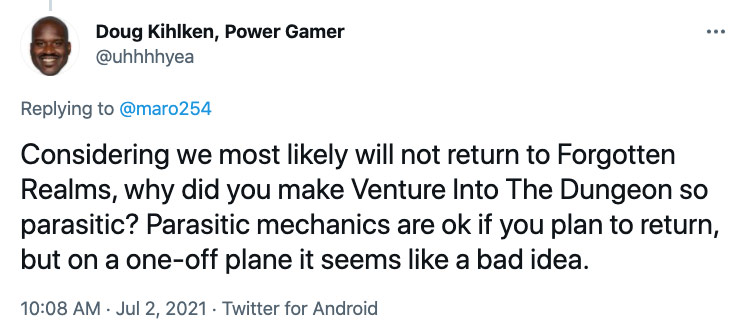
To answer your question, I need to begin by addressing several false assumptions interwoven into the question.
Before I do that, though, let me first define what a "parasitic mechanic" is for the readers that might not have heard this term before. A parasitic mechanic is a mechanic that's only useful when interacting with other cards in the same set (or same block back when we had blocks). It's the opposite of "backwards compatible," that is, things that work well with old existing Magic cards. A classic example of a parasitic mechanic is splice onto Arcane from Champions of Kamigawa block. To use the mechanic, you had to have instants or sorceries with the subtype Arcane. That didn't exist until Champions of Kamigawa, so those cards only worked with other cards in that block.
With that out of the way, let's address your assumptions:
Assumption #1: Parasitic mechanics are only okay if you plan to return to the world – Parasitic mechanics can be very fun. For example, Slivers are one of Magic's most popular creature types and are very parasitic. When they were introduced in Tempest block, there was no guarantee that they were ever returning, and the audience adored them. Sets do have a problem if there are too many parasitic mechanics in them, but a mechanic being parasitic, unto itself, isn't inherently a problem.
Assumption #2: Venture into the dungeon is parasitic – Let me start by saying parasitism is more of a scale than a set condition. Venture into the dungeon sits more in the middle than at either end. The thing that keeps it from being super parasitic is that the thing it combines with, dungeons, aren't another card in your deck but an outside game piece that you automatically get when you venture. In contrast, if I open a splice onto Arcane spell and never open an Arcane spell, it's hard to use.
In gauging how strong a mechanic's parasitism is, our main test involves asking this question: can you play just one in your deck? With venture into the dungeon, you can easily play just one card and get one of three effects when you use it. The reason it's in the middle and not at the non-parasitic end is that the mechanic encourages you to want to play more cards in your deck to get the maximum benefit. The abilities get stronger the deeper into the dungeon you go, so there is strategic advantage in playing more of them together.
Assumption #3: We're never returning – As I said above, I can neither confirm nor deny the return of a D&D-themed set.
With all that out of the way, let me answer your question. We felt venture into the dungeon was a great flavor fit for Adventures in the Forgotten Realms. We thought players would enjoy it, even if this ultimately ends up being the only time we ever use it. And it's not as parasitic as I believe you think it is.
"Time's Up"
That's all the questions I'm able to answer today. As always, I'm eager to get your feedback on any of my answers or on Adventures in the Forgotten Realms itself. You can email me or contact me through any of my social media accounts (Twitter, Tumblr, Instagram, and TikTok).
Join me next week when I answer more of your questions.
Until then, may you enjoy exploring the Forgotten Realms.
#855: Ice Age with Chris Page
#855: Ice Age with Chris Page
30:18
I sit down with designer Chris page to talk about the design of Ice Age.
#856: Parasitism
#856: Parasitism
30:39
In this podcast, I talk about what the term "parasitism" means in Magic design and then look at the mechanics in Standard and talk about how parasitic they are.
- Episode 854 Creature Tokens, Part 2
- Episode 853 Odyssey with Randy Buehler
- Episode 852 Creature Tokens, Part 1

